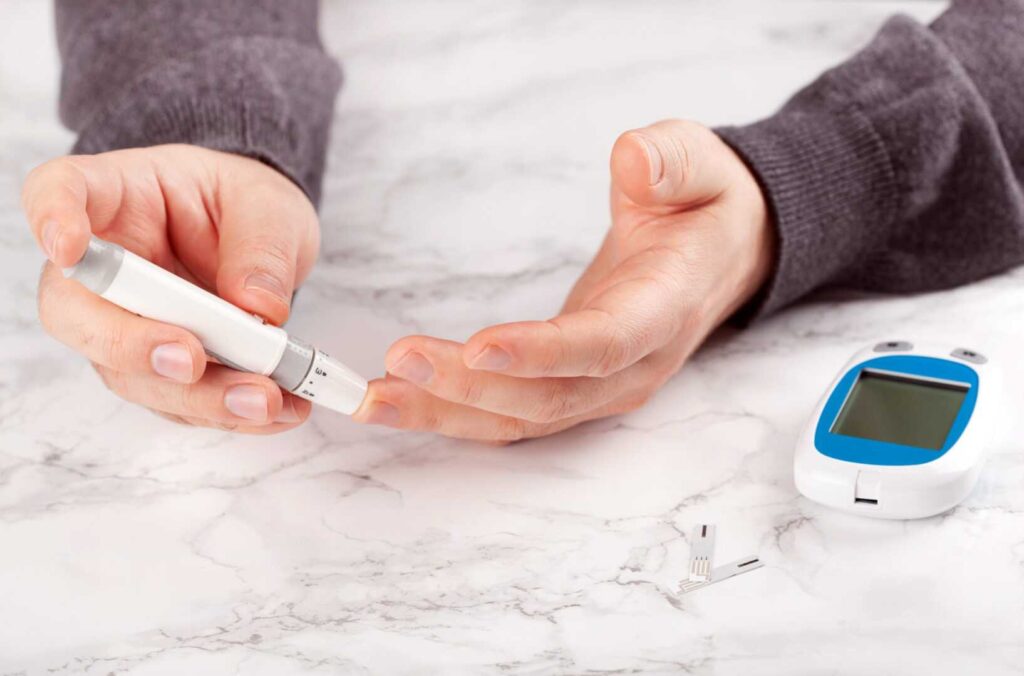Diabetic ketoacidosis (DKA) is a serious and potentially life-threatening complication often associated with type 1 diabetes, though it can also affect those with type 2 diabetes in some cases. Understanding the early signs and knowing some measures to manage your condition at home can be vital in preventing the escalation of this complication. This blog aims to provide crucial information on recognizing the early warning signs, diabetic ketoacidosis treatment at home, and the importance of seeking professional medical advice.
Contents
Can Diabetic Ketoacidosis Be Treated At Home?
 Diabetic ketoacidosis (DKA) is a serious condition that requires immediate medical attention and cannot be safely treated at home. It occurs when high levels of ketones accumulate in the blood, leading to acidosis. Treatment typically involves hospitalization to administer intravenous fluids, insulin therapy, and electrolyte replacement. These measures are critical to quickly and effectively restore the body’s balance of fluids and electrolytes, lower blood sugar levels, and address any complications that may arise.
Diabetic ketoacidosis (DKA) is a serious condition that requires immediate medical attention and cannot be safely treated at home. It occurs when high levels of ketones accumulate in the blood, leading to acidosis. Treatment typically involves hospitalization to administer intravenous fluids, insulin therapy, and electrolyte replacement. These measures are critical to quickly and effectively restore the body’s balance of fluids and electrolytes, lower blood sugar levels, and address any complications that may arise.
While some aspects of diabetes management can be conducted at home to help prevent the onset of DKA, once DKA develops, it is beyond the scope of home care. Early detection and intervention are crucial.
What Are The Signs Of Medical Attention For Diabetic Ketoacidosis?
Recognizing the signs that medical attention is needed for diabetic ketoacidosis (DKA) is crucial for preventing serious complications. If you or someone you know has diabetes and exhibits any of the following symptoms, it’s important to seek medical help immediately:
- High Blood Sugar Levels (Hyperglycemia): Persistent high blood sugar levels that do not decrease with usual treatment measures can be a sign of developing DKA.
- Ketones in Urine: The presence of moderate to high levels of ketones in the urine is a clear indicator of DKA. Home ketone testing kits can help monitor this.
- Extreme Thirst and Frequent Urination: While common in diabetes, these symptoms can significantly worsen in the lead-up to DKA.
- Nausea and Vomiting: Persistent nausea and vomiting can lead to dehydration and are signs that DKA may be developing.
- Abdominal Pain: Unexplained or severe abdominal pain is a common symptom of DKA.
- Fatigue and Weakness: Excessive tiredness and weakness without a clear reason can be indicative of DKA.
- Shortness of Breath: Rapid, deep breathing or shortness of breath, known as Kussmaul respiration, is a sign of serious ketone buildup.
- Fruity-Scented Breath: A sweet, fruity odor on the breath is a hallmark sign of significant ketone production.
- Confusion or Altered Mental State: Dizziness, confusion, or difficulty in thinking clearly can occur as DKA progresses.
- Loss of Consciousness: In severe cases, DKA can lead to unconsciousness or coma, requiring immediate emergency medical intervention.
DKA is a medical emergency that necessitates prompt treatment in a hospital setting to correct the underlying high blood sugar, acidosis, and electrolyte imbalances. If you suspect DKA, do not delay in seeking medical attention.
What Are Some Diabetic Ketoacidosis Treatment At Home?
 While diabetic ketoacidosis (DKA) requires immediate medical attention and cannot be treated solely at home, there are important steps individuals with diabetes can take at home to manage the condition. These measures are primarily preventive and supportive:
While diabetic ketoacidosis (DKA) requires immediate medical attention and cannot be treated solely at home, there are important steps individuals with diabetes can take at home to manage the condition. These measures are primarily preventive and supportive:
Regular Blood Glucose Monitoring
Continuous monitoring of blood glucose levels is a cornerstone of diabetes management. This proactive approach allows individuals to respond quickly to any significant fluctuations in blood sugar. This is crucial for preventing hyperglycemia and, by extension, DKA. Modern glucose meters and continuous glucose monitoring systems provide real-time feedback, enabling timely adjustments to diet, exercise, and medication.
Adjusting Insulin Dosage
Insulin therapy is critical for managing diabetes, especially for individuals with type 1 diabetes. The precise adjustment of insulin dosages, under the guidance of a healthcare provider, helps maintain blood glucose levels within the target range. This customization is often based on factors such as carbohydrate intake, physical activity, and current blood glucose readings. Hence, requiring individuals to be well-informed and vigilant.
Staying Hydrated
Adequate hydration is key for preventing the concentration of blood glucose levels and for facilitating the excretion of excess glucose through urine. During episodes of high blood sugar, increased fluid intake helps mitigate the risk of dehydration, a common and dangerous complication of DKA. Encouraging the consumption of water and other non-sugary, non-caffeinated beverages can support hydration needs.
Ketone Monitoring
When the body starts breaking down fat for energy due to insufficient insulin, ketones are produced, which can lead to DKA if left unchecked. Regularly testing for ketones during periods of illness, stress, or when blood glucose levels are consistently high, provides early warning signs. At-home ketone testing kits, available as urine strips or blood ketone meters, are valuable tools for monitoring ketosis.
Healthy Eating
A balanced diet rich in fruits, vegetables, whole grains, and lean proteins supports overall health and diabetes management. Carbohydrate counting or using the plate method are strategies that can help maintain blood glucose levels within a healthy range. Consulting with a dietitian can provide tailored advice to meet individual nutritional needs and preferences.
Avoiding Infections
Infections can cause a spike in blood glucose levels, potentially triggering DKA. Good personal hygiene practices, such as regular handwashing, and staying up to date with vaccinations, including the flu shot and other recommended vaccines, can reduce the risk of infections. Being vigilant about skincare and foot care is also important, as cuts and sores can become entry points for infection.
Stress Management
Stress affects blood sugar control by releasing stress hormones that can raise blood glucose levels. Techniques such as mindfulness, meditation, regular physical activity, and engaging in hobbies can alleviate stress. Professional support from a psychologist or counselor can also be beneficial for managing chronic stress and its impact on diabetes.
Having a Sick Day Plan
Illness can disrupt diabetes management, making it harder to control blood sugar levels. A pre-established “sick day” plan, developed with a healthcare provider, outlines how to adjust insulin dosages, hydration, and carbohydrate intake during illness to prevent DKA. This plan may include more frequent monitoring of blood glucose and ketone levels, as well as specific guidelines on when to seek medical help.
Education and Awareness
Knowledge is power in managing diabetes. Understanding the symptoms of high blood sugar, hypoglycemia, and DKA empowers individuals to take appropriate action quickly. Diabetes education programs and resources can enhance one’s ability to manage their condition effectively, recognize warning signs, and understand when to seek professional advice.
Emergency Plan
Despite best efforts to manage diabetes at home, situations requiring emergency medical attention can arise. An emergency plan should include instructions on when and how to contact healthcare providers, the location of the nearest emergency room, and a list of medications and medical conditions. This plan ensures that individuals and their families are prepared to act swiftly in critical situations, potentially saving lives.
By incorporating these strategies into daily life, individuals with diabetes can significantly reduce their risk of developing DKA. However, it’s vital to remember that this diabetic ketoacidosis treatment at home, rather than replace, the need for professional medical intervention in managing diabetes and preventing serious complications.
Can Drinking Water Help Diabetic Ketoacidosis?
 Drinking water can play a supportive role in managing high blood sugar levels. Also, may help prevent the progression of diabetic ketoacidosis (DKA) under certain conditions. When blood sugar levels are elevated, the body tries to eliminate excess glucose through urine. This can lead to dehydration. Drinking water helps to rehydrate the body and dilute the concentration of glucose in the blood, potentially helping to lower blood sugar levels indirectly.
Drinking water can play a supportive role in managing high blood sugar levels. Also, may help prevent the progression of diabetic ketoacidosis (DKA) under certain conditions. When blood sugar levels are elevated, the body tries to eliminate excess glucose through urine. This can lead to dehydration. Drinking water helps to rehydrate the body and dilute the concentration of glucose in the blood, potentially helping to lower blood sugar levels indirectly.
Moreover, adequate hydration is essential for kidney function. It is crucial for flushing out toxins, including excess ketones, from the body. However, it’s important to understand that once DKA has developed, drinking water alone is not sufficient to reverse the condition. It requires medical treatment to correct the underlying high blood glucose levels, acidosis, and electrolyte imbalances. Therefore, while staying hydrated and drinking water is beneficial, it should not be considered a standalone treatment for DKA.
Conclusion
In conclusion, diabetic ketoacidosis treatment at home requires a comprehensive approach that includes regular monitoring of blood sugar levels, staying hydrated, eating a balanced diet, adjusting insulin dosages as needed, and being vigilant about signs of infection. While drinking water and maintaining healthy lifestyle habits are important for managing diabetes, they are part of a larger strategy that includes medical oversight.
It’s crucial to recognize the symptoms of DKA early and seek professional medical treatment immediately, as home remedies alone are not sufficient to treat this serious condition. With the right precautions and care, individuals with diabetes can lead healthy lives and minimize the risk of developing DKA. Do you want to get rid of diabetes? Join our online diabetes treatment program and reverse Diabetes naturally through lifestyle changes such as a Personalized Diet plan, Exercise, Yoga, dieticians, and health coaches.

